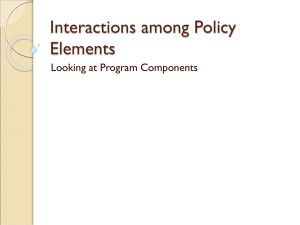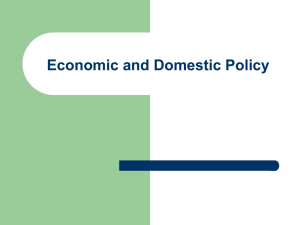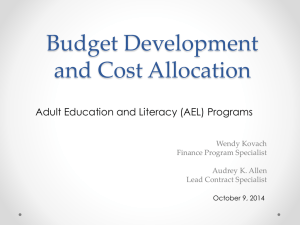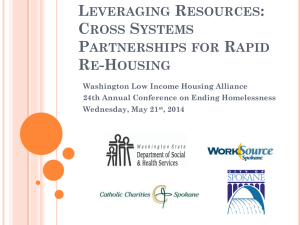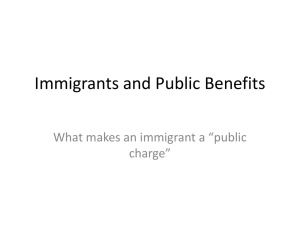Update on Maine`s Safety Net - Maine Equal Justice Partners
advertisement
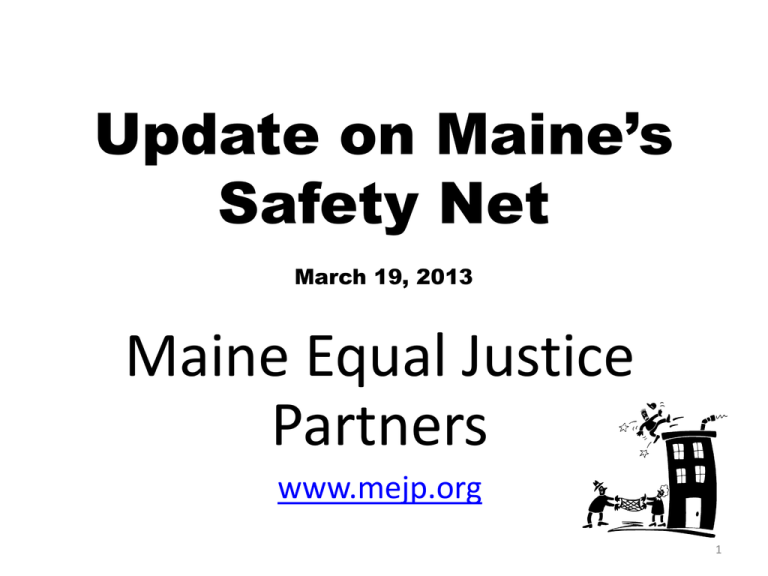
Update on Maine’s Safety Net March 19, 2013 Maine Equal Justice Partners www.mejp.org 1 About Maine Equal Justice Partners (MEJP) • We work to find solutions to poverty and improve the lives of people with low income in Maine. • We accomplish our mission through: – Public policy advocacy in the legislature and with governmental agencies – Legal representation and impact litigation on systemic issues – Statewide outreach and training on issues affecting people with low income and the supports that can help them prevent or move out of poverty • MEJP focuses its work on the issues that affect people’s daily lives access to adequate health care, food and income security, supports for working families, and higher education and training opportunities. • Our website contains much information about public benefit programs— www.mejp.org 2 Over the last two years, safety net programs have been the target of numerous legislative cuts including: • • • • Imposition of a 60-month time limit and “full family sanctions” in TANF – By mid-October 2012, 2,231 families had reached the new 60-month time limit. Going forward 79 additional families will receive notice each month that they are nearing the limit. Hundreds more families will lose benefits due to the imposition of full-family sanctions. Elimination of MaineCare eligibility for the following groups: – 28,500 parents between 100-200% FPL --PARTLY DISALLOWED BY FEDERAL GOVT. – 6,500 young adults –DISALLOWED BY THE FEDERAL GOVT. – 500 legal immigrants – 5,649 seniors and people with disabilities who will lose some or all help from Medicare Savings Program (MSP) or Drugs for the Elderly (DEL) – 19,000 childless, non-disabled adults—Waiting List ONLY (those currently on waiting list and not yet enrolled will not be able to access the program) Cuts to programs for children and families – 216 children will lose access to Head Start – 750 families will lose Home Visiting services – 1,200 children will lose child care subsidies Cut to the General Assistance Program (GA) – Thousands more will be impacted by cuts to GA; municipalities will be harmed by a reduction in State reimbursement for their GA costs. 3 MaineCare Cuts--Eligibility Childless Adult Waiver (“Non-Categoricals”): Enrollment in the Childless Adult waiver program is frozen. For State Fiscal Year ‘13, spending in the program was cut from an annual cap of $80.3 million to $40 million. Individuals receiving benefits at the time of this cut (February 2012) will remain eligible, but no new individuals will be able to enroll. There are currently approximately 10,300 members receiving benefits in this group; Approximately 24,000 are on the waiting list and cannot be served. 4 TIP: Any Mainecare Member Currently On The Childless Adult Program Must Be Sure To Complete And Send In Their Annual Recertification Form. The program was frozen for new applicants, but people who are on the program may stay on. This means that if someone is on the program now, it is extremely important that they fill out and return the review form to recertify for the program. If they don’t, they WILL lose coverage and will be unable to get MaineCare coverage back unless they qualify under a different MaineCare group like disability or pregnancy. Updating addresses when they change as quickly as possible becomes even more important. Recertification is now available online at My Maine Connection located at https://www1.maine.gov/benefits/account/login.html. 5 Low-income parents with incomes between 133% and 200% of the federal poverty level: Parents 100-133% FPL: The Federal government has rejected Maine’s request to eliminate MaineCare coverage for these 14,500 parents until December 31, 2013. Parents 133-150% FPL: MaineCare benefits for these parents was terminated on March 1, 2013. However, many of these parents with income between 133% FPL ($2,116 per month for family of 3) and 150% FPL ($2,387 per month for a family of 3) were found eligible for “Transitional” MaineCare if they were working or receiving child support when they lost their regular MaineCare benefits. This coverage transition should have happened automatically. Any family that thinks they should receive Transitional MaineCare, but did not, should check with their case worker. Transitional MaineCare lasts for 3, 6, or 12 months depending upon a family’s circumstances. Parents 151-200% FPL: MaineCare benefits for these parents was terminated on March 1, 2013. These parents are not eligible for “Transitional” MaineCare. Important Note: Any parent who lost coverage a result of this cut and who is pregnant should reapply for MaineCare. Pregnant women remain eligible for MaineCare if their income is 200% FPL or below. 6 Young Adults—19 and 20 years old with incomes below 150% of the Federal Poverty Level: The federal government rejected the State’s request to eliminate MaineCare coverage for 6,500 young adults (19 and 20 years old) who are under 150% of the poverty level ($16,755/year for a single individual). Coverage for this group of young adults is protected until 2019. 7 Cuts to MaineCare for Seniors and People with Disabilities: • The Drugs for the Elderly Program (DEL) is the longstanding state-funded program that helps seniors and people with disabilities afford their prescription drugs. This cut has gone into effect. It eliminates eligibility for people with income between 175-185% FPL. For example, a single person with income over $19,548 a year will lose help. These are typically individuals with serious health conditions such as diabetes, heart disease or Lou Gehrig’s disease. (260 people affected). • The Medicare Savings Program (MSP), sometimes called QMB, SLMB, and QI, helps seniors and people with disabilities pay for prescription drug and other Medicare costs. The legislature voted to eliminate coverage for seniors and people with disabilities with incomes between 175-185% of the federal poverty level. The federal government agreed to permit the State to implement this cut to the MSP. 8 Maine has opportunity to accept federal funds to cover 69,500 people beginning January 1, 2014 • The Affordable Care Act (ACA) enables states to provide Medicaid coverage to adults with incomes up to 138% of the federal poverty level ($15,856/year for an individual; $26,951/year for a family of three) beginning January 1, 2014. • Representative Linda Sanborn (D. Gorham) has introduced a bill to require the State to take advantage of this unprecedented opportunity. • If Maine does not say “yes” to accepting these funds, 10,000 childless adults and 14,500 low income working parents currently receiving coverage will lose it on January 1, 2014. • The federal government will pay 100% of the cost for covering all “newly eligible” individuals for the first 3 years. After that, the State’s share would still be considerably smaller than under the current MaineCare program. • Accepting these funds will create more than 3,100 new jobs; bring $250 M new federal dollars to Maine and generate $16-18 M dollars in new state revenue. 9 Some MaineCare services were also cut. These cuts are now in effect. Vision services: routine eye exams will now be available once every 3 years instead of every 2 years as currently allowed; Chiropractic services: limited to 12 visits per year; Smoking cessation services: All smoking Cessation services have been eliminated; Methadone Treatment/clinics: the bundled weekly treatment rate was reduced from $70 to $60 per week; Reimbursement rates: 10% provider rate reduction for the following services: Occupational and physical therapy Podiatry Adult family Care; Brand Name Prescriptions: Brand name drugs will be limited to 2 prescriptions per month (the current limit is 4 per month). But, additional brand name drugs may be available if your medical provider says that they are medically necessary for you; and Hospital Services: Limited to 5 in-patient hospital stays per year. 10 Limits on Methadone and Suboxone Methadone and Suboxone use by MaineCare members will be subject to heightened scrutiny after 24 months of use. To continue receiving this service, members will have to get “prior approval” from DHHS and show that continued use is “medically necessary.” For more information on these limits: http://www.maine.gov/dhhs/oms/pdfs_doc/member/December 2012_mbr_opioid,suboxone,methadone.pdf 11 Limits on certain MaineCare pain medications (Opioids) A prescription for certain medications (opioids) for acute pain will now be provided for only 15 days. After that, a face-to-face visit with the prescriber is required to get prior authorization for second 15day prescription. After 45 days, if these drugs are still medically necessary, a person may qualify to get opioid drugs for long-term chronic pain with prior authorization. Important note: 60-day prescriptions are allowed following surgery without these limits. To get opioid drugs for chronic pain, the person must have: – Failed to respond well to a prescribed alternative treatment; – Completed the prescribed alternative treatment and the pain is getting worse; or – Completed at least half of the prescribed alternative treatment, and the prescriber determines that the alternative treatment is not adequately controlling the pain. These new limits do not apply if the drugs are prescribed: For symptoms related to HIV, AIDS, cancer and certain other diseases and conditions identified by rule; During inpatient treatment in a hospital or during hospice care; At certain qualifying low doses; or For treatment of addiction, in which case the limits applicable to methadone and buprenorphine and naloxone combination drugs apply. Please note: These limits will not apply to people on the Medicare Savings Program (MSP) who are covered by Medicare Part D. 12 The New TANF Time Limit Rules There is a new 60-month time limit for TANF. Assistance for families reaching this limit will end unless they qualify for an “extension” or “exemption.” DHHS must give TANF families 120 days notice that they are about to reach their 60th month. This notice must give the family the opportunity to meet with their worker to see if they qualify for an exemption or extension. It is important that families meet with their worker if they want to continue to receive TANF. – A hardship “extension” means that you can get benefits after you reach the 60-month limit. – An “exemption” stops the clock—meaning that months you get TANF while exempt will not count toward the time limit, including months in the past. 13 What months count toward the 60-month time limit? Any month that an individual got TANF cash assistance as an adult since June 1, 1997 will count toward that family’s 60month time limit. (DHHS may only be able to identify those who have received TANF since 2002). A month will count: – Whether the adult got TANF in Maine or any other state or U.S. territory; – Even if the adult was in the Parents as Scholars program; or – If the adult got TANF by mistake for that month unless they repaid that amount. Once they repay the overpayment for that month it will no longer count toward the limit. 14 Exemptions: Some months don’t count—these months are “exempt” from the time limit. Here are some examples of months that are exempt and will not count toward the 60-month limit: – Months the adult was getting SSI and only children were on the TANF grant; – Months that only children and no adult were on the TANF grant (including months the adult did not receive TANF because of a sanction); – Months that children getting TANF were living with a caretaker relative (like a grandparent) who is not the parent, and that caretaker relative was NOT on the TANF grant; and – Months that a Native American was living at any of the Passamaquoddy, Micmac or Maliseet reserves; There are additional reasons for exemptions listed in our TANF time limit guidance. http://www.mejp.org/content/tanf-time-limit-rules-intro 15 Extensions: People may be able to get help from TANF after they reach the 60-month limit if they qualify for a “hardship extension”. Length of Extensions: Families can qualify for most extensions for as long as they are experiencing the qualifying hardship. However, the family will have to renew the extension at least every 6 months. Some extensions are only available for one 6-month period. Verification: If a family needs help gathering documentation for an extension, DHHS rules require their worker to assist them. Application/Decision: A person seeking an extension should clearly state their request to their case worker. It is helpful to follow up by making that request in writing. DHHS must make a written decision responding to that request and that decision may be appealed through the fair hearing process. 16 Some reasons people may get an extension: They have experienced domestic violence; They have a physical or mental condition that prevents them from getting or keeping a steady job; They need to stay home most of the time to care for a disabled family member; They are in an approved education or training program; They are working at least 35 hours a week and still need TANF; They are in their last trimester of pregnancy; They lost a job they had for at least 12 months through no fault of their own after they got 60 months of TANF; or Certain emergencies 17 Extensions granted through October 2012 • 2,152 cases received termination notices between February and October • An average of 79 cases per month will receive termination notices in the future. • 44% (953) of all cases receiving a termination notice requested an extension • 26% (569) of all cases receiving a termination notice received an extension Extensions Requested: • • • • • • • • Victim of Domestic Violence—4% (41 families) Caring for a Disabled Family Member—17% (158 families) Disabled—58% (553 families) Education/Training—16% (150 families) Working Family—2% (17 families) Pregnant—2% (18 families) Job Loss—1% (7 families) Emergency—2% (19 families) 18 Domestic Violence Extension How is “domestic violence” defined in the rules? – A physical act or threat of physical injury; – Sexual abuse of a child or caretaker of a child; or – Psychological effects of the abuse. In order to receive a domestic violence extension a person must: Work with DHHS to create an employment plan. This plan will include steps to reduce the threat of violence and prepare for employment. DHHS is required to give the family information about services offered by domestic violence resource centers; and Provide records or other documentation from the court, law enforcement, child protective, social services, a mental health or other medical provider; or other trustworthy source; or Provide a sworn statement from a person other than themself with knowledge of the domestic violence. This might be someone from an agency that helps people who have experienced domestic violence or a friend or family member. NOTE: This extension is available to a family at any time that they qualify for it, even if they have passed their 60th month and have not received TANF for a period of time. 19 Disability Extension How is “disability” defined? A disability means that a person has a physical or mental condition that makes them unable to engage in gainful employment. This means that a person must have a condition that greatly limits their ability to support their family. Important NOTE: the condition does not need to be as severe as it does to qualify for SSI or Social Security Disability benefits. Just because a person is denied SSI does not necessarily mean that they are ineligible for a disability extension. In order to receive an extension based on disability a person must: • • • • Provide medical evidence on forms provided by DHHS (forms under revision) of a physical or mental condition that limits their ability to work; If required by DHHS, apply for disability benefits from SSI, Social Security Disability Benefits, Railroad Retirement Disability, or MaineCare in the disability category; If required by DHHS, provide evidence that they have applied for SSI or Social Security Disability benefits and the status of the application if required by DHHS. (e.g. - letter from a lawyer or a notice from the SSA); If required by DHHS, show that they are complying with a rehabilitation plan through the Vocational Rehabilitation (VR) program, or that they are on a waiting list for VR. NOTE: This extension is available to a family at any time that they qualify for it, even if they have passed their 60th month and have not received TANF for a period of time. 20 Extension for Caring for a Disabled Family Member Someone may qualify for an extension based on needing to care for a disabled family member if: • They are needed to care for a family member who lives in the same home and is on the TANF grant, or would be on the grant if not for their disability. For example, a disabled child receiving SSI is not on the TANF grant, but would qualify if not receiving SSI; • The adult or child needing care has a temporary or permanent mental or physical illness or incapacity and no other care is reasonably available; • They provide proof from a qualified medical professional (can be a counselor): Verifying the household member’s illness or disability; and Verifying that the household member needs full-time care. Full-time care means care that reasonably prevents the caretaker from being able to work; and • They make a plan with DHHS that will enable them to eventually return to work or find some other way to support the family. NOTE: This extension is available to a family at any time that they qualify for it, even if they have passed their 60th month and have not received TANF for a period of time. 21 Education or Training Extension Someone may qualify for an education/training extension if: In their 60th month of receiving TANF they are in good standing and making good progress toward completing an education or training program that is approved by DHHS. This means they must: Maintain at least a 2.0 GPA (grade point average); Participate for the required number of hours and verify that participation; and Provide their ASPIRE worker with their financial aid award letters and grades as they become available. Please note: The following education and training programs do not qualify for an extension: (1) Adult Basic Education; (2) GED activities; (3) English as a Second Language (ESL); or (4) High School. 22 Working Families Extension Someone may qualify for the working family extension if: – they are working at a paying job for at least 35 hours a week at the time they reach their 60th month; and – they are still financially eligible for TANF. You can visit our website at http://www.mejp.org/content/are-you-working-and-gettingtanf to determine whether someone still qualifies for TANF while they are working. 23 Pregnancy Extension Someone may qualify for the pregnancy extension if: – She is in the last trimester of her pregnancy when she reaches her 60th month of TANF assistance; and – She is the only adult (or minor parent head-ofhousehold) on the TANF grant in the household. Length of extension: One extension of up to 6 months. This extension can be used for 3 months in the last trimester of pregnancy and the first three months after the child is born. 24 Job Loss Extension Someone may qualify for a job loss extension if: – They have been employed for at least 12 months after they reach their 60-month time limit. This doesn’t have to be 12 months in a row, just 12 months in total after leaving TANF. There is no limit on the number of these extensions a family can get provided they work 12 months between extensions; – They lost a job through no fault of their own (see “good cause” for job loss in our TANF time limit guidance (http://www.mejp.org/content/tanf-time-limit-rules-intro) and – They applied for unemployment benefits, but were not eligible because they didn’t have enough earnings to qualify. 25 Emergency Situation Extension How is “emergency situation” defined? Emergency situation means circumstances that: (1) are beyond the control of the family; and (2)prevent the adult(s) in the household from working. Examples of an emergency may include: – The death of a child, parent, or spouse; – Homelessness due to a disaster such as fire, flood, or other natural disaster; or – Being the victim of a violent crime. These examples all sound very serious. But remember, what is needed for an emergency extension is something beyond the family’s control and prevents the adult from working. This could also mean that a period of homelessness or a divorce/separation that leaves a family without income could be considered an emergency. NOTE: This extension is available to a family at any time that they qualify for it, even if they have passed their 60th month and have not received TANF for a period of time. There is no limit on the number of Emergency extensions that a family can get if they meet the requirements for this extension. 26 In determining whether to grant an extension to a family that has reached 60 months, DHHS will consider whether the family meets the requirements for that extension. But, even if the family meets the requirements for an extension, DHHS will deny the extension request if: – The adult turned down a job offer or quit a job without “good cause” within the last year (see New TANF Time Limits Rules handout for the list of “good cause” reasons for losing a job or refusing to accept a job); – The adult was sanctioned two or more times in the last year because they didn’t cooperate with ASPIRE, Support Enforcement, or Quality Control; or – Within the last three years, they were sanctioned for intentionally violating a program rule to get benefits for which they were not eligible. 27 What if someone disagrees with a DHHS decision to deny a request for an exemption or extension? DHHS must give people a written notice telling them that their request for an exemption or extension has been approved or denied. If it is denied, they must explain the reasons for the denial and tell the person how to appeal that decision. People must request a fair hearing within 30 days if they want to appeal. If someone decides to appeal, they should tell their worker that they want a fair hearing. A fair hearing offers a chance to be listened to by a fair hearing officer. The fair hearing officer will look at the record and the law to make a new decision in writing. Under this new rule, people will not be eligible for continued TANF assistance while waiting for the decision from the appeal. This means that TANF will end as the notice states. But, if they win their appeal, they will get retroactive benefits back to the time set by the hearing decision. Important Note: MEJP questions the legality of denying continued benefits during appeal. DHHS is considering changes to increase due process in this area, but decisions have not been finalized. Please call if you have questions about this issue. 28 The new TANF “full family sanction” rules First Sanction: The first time that someone is sanctioned, DHHS will reduce their TANF benefit by removing the adult from the grant. For example, a family of 3 getting $485 per month would be reduced to $262 per month (the maximum grant for a family of 2 without an adult on the grant). For the first sanction: • If they comply with the rule anytime within 90 days after they were sanctioned, they will get their benefits back as soon as they comply; • If they do not comply within 90 days, their whole family will lose ALL TANF benefits. They can get the benefits back for the whole family as soon as they follow all ASPIRE rules. Subsequent Sanctions: The second time and any future time that the adult is sanctioned, the whole family will lose benefits right away. This sanction will continue until the adult complies with the rule. They can get the benefits back for the whole family as soon as the adult follows all ASPIRE rules. Important Note: Before any family, including children, is sanctioned the family must have the chance to show if they have “good cause” for not following the rule. See TANF Time Limits publication on the MEJP website for a complete list of good cause reasons. 29 Opportunities to Improve the TANF Program in 2013 In this current legislative session there will be several opportunities to improve Maine’s TANF Program and mitigate some of the hardships experienced by families: 1. Proposals arising from General Assistance working group (no LD# or scheduled hearing yet): – Create a new TANF extension for parents who are not “job ready” (i.e. low literacy, limited English language proficiency, learning disabilities, cognitive impairments, or living in an area with higher than average unemployment); – Improve implementation of current extensions and ensure better notice and the right to apply for an extension; – Direct DHHS to study eliminating the “deprivation” requirement in TANF, meaning that all 2-parent families who meet the TANF income eligibility guidelines would be eligible. 30 2. Speaker Eves has sponsored a bill (No LD# or public hearing yet) to create an assessment process in the TANF program so that families with disabilities receive the supports and services they need. Better assessment of families’ strengths and challenges coupled with customized plans for progress are critically needed, especially in light of the new TANF time limit. Currently, many families are timing off of TANF without the tools and supports they need to provide for their families. Under this proposal, TANF families that are facing barriers to work would be assessed by a qualified professional and a plan would be put in place to better support these families. 31 Please see our publications: The New TANF Time Limit Rules and Understanding TANF/ASPIRE: What are your Rights and Responsibilities? available online at: http://www.mejp.org/content/tanf-time-limit-rules-intro http://www.mejp.org/sites/default/files/TANF-ASPIRE-guide.pdf 32 Changes to General Assistance Program effective July 1, 2012 • A temporary limit on GA for housing. Recipients are limited to 9 months of housing assistance in a year unless they meet one of the exceptions to this limit. People with serious physical or mental health conditions; people applying for SSI; and others facing emergencies like eviction should qualify for an exception and continue to get help with housing. People getting housing help since this law took effect will reach this limit at the end of March. This change ends on June 30, 2013. • There will be a temporary 10% reduction in the General Assistance overall maximum level of assistance. For example, the overall maximum for a single person in Bangor will drop from $611 to $550 a month. This change ends on June 30, 2013. • There will be a temporary reduction from 90% to 85% in reimbursement to the municipalities spending the most on GA. This change ends on June 30, 2013. • The Department of Health and Human Services will set up a new unit to help people with disabilities apply for SSI. Many have trouble navigating the SSI application process. They often have no income while they wait months for a decision and must turn to GA for help. This new unit will offer much needed help to these individuals; and • The Commissioner of Health and Human Services will create a working group to examine the GA program and make recommendations for changes to the next legislature. 33 Opportunities to Protect the GA Program in 2013 The General Assistance Working Group has put forward a package of proposals that would make changes to the GA program. Some of these proposals would take strain off of the GA program while benefitting low-income individuals and families. (These proposals will be part of a bill but there is no LD# or scheduled public hearing yet.) Some of these proposals include: • Promote the Alternative Aid Program; • Create a new extension for families timing off TANF at 60 months so they can get TANF until they become “job ready”; • Improve implementation of current TANF extensions and ensure better notice and the right to apply for an extension; • Direct DHHS to study eliminating the “deprivation” requirement in TANF, meaning that all 2-parent families who meet the TANF income eligibility guidelines would be eligible; • Restore public benefits for legal immigrants who lost MaineCare, TANF and Food Supplement benefits in the 2012-2013 budget; • Fix the hardship exception for legal immigrants so they can access TANF and Food Supplement benefits until they receive work authorization AND find work; • Create a hardship exception for legal immigrants so they can access TANF and Food Supplement benefits until they are “job ready” if they are participating in education or training activities in order to become employable. 34 Budget cuts targeting certain legal immigrants The elimination of MaineCare for asylum seekers and a 5-year wait period for lawful permanent residents (LPRs) (unless they are pregnant or under age 21) 500 people lost their MaineCare in October of 2011. * MEJP and the ACLU of Maine have filed a lawsuit against DHHS claiming this cut violates the Equal Protection Clause of the U.S. Constitution. New applicants for TANF and Food Supplement benefits (FS) who are asylum seekers or LPRs under 5 years now must fit into one of these hardship categories to get benefits: • 65 or older; • Disabled (SSI standard); • Domestic Violence; or • Waiting for work documentation. (GA work group proposal would extend this to apply until the immigrant actually found work) *People getting FS as of January 1, 2012 were “grandfathered” and will continue to get FS as long as they are eligible. *People getting TANF as of December 1, 2012 were “grandfathered” and will continue to get TANF as long as they are eligible. NOTE: These benefits would be restored in whole or in part if recommendations of the GA working group are adopted (see previous slide) 35 THANK YOU for the work you do and for taking the time to come to this workshop today. Any Final Questions? 36



